Peru Diary 3
Sept 18
 A day to play proper
tourists! Our guide, Eduardo, took us first to the Yavari, a former
steam ship constructed in England in 1862, then shipped (with its
sister ship) in 2766 parts to Peru, then brought over the Andes to Lake
Titicaca on mules and reconstructed in Puno - a 6 year process in all.
It was bought as a wreck
by an English woman in 1982 and has been restored. The current captain,
Carlos Saavedra, showed us around with a wealth of humorous
pearls of wisdom, and the odd fact. It took quite an effort to get him
to stop - but not until after we had seen the whole ship, including the
'new' diesel engine (1914), which removed the need to store tons of
llama dung for the steam engine...
A day to play proper
tourists! Our guide, Eduardo, took us first to the Yavari, a former
steam ship constructed in England in 1862, then shipped (with its
sister ship) in 2766 parts to Peru, then brought over the Andes to Lake
Titicaca on mules and reconstructed in Puno - a 6 year process in all.
It was bought as a wreck
by an English woman in 1982 and has been restored. The current captain,
Carlos Saavedra, showed us around with a wealth of humorous
pearls of wisdom, and the odd fact. It took quite an effort to get him
to stop - but not until after we had seen the whole ship, including the
'new' diesel engine (1914), which removed the need to store tons of
llama dung for the steam engine...
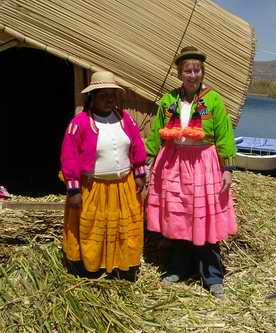 Yavari Steamship
Yavari Steamship
Our speedy launch then took us to join scores of other tourist boats
visiting the Uros islands, which are constructed of reeds and float on
the lake. Each island is home to a few families, who earn most of their
money from tourism - displaying the colourful costumes, singing, taking
people out in reed boats & selling woven or knitted items. The one
we visited farmed fish as well - trout, introduced into the lake with
king fish in the 1940s. A disturbingly high proportion of the group
were serious shoppers, which no doubt pleased the islanders. We also
had a stately ride in a reed boat, and some people dressed up in the
islanders' gear for photo calls, as you do!
Dressing up!
We then went back on the speedy launch to visit the Island of
Tequile, where we lunched in one of the farmsteads (plus dancing,
demonstration of knitted items, more selling..) and then walked across
the island via the surprisingly large central square of the 'town' on
the crest of the island and back to the launch. The island is almost
entirely terraced with stone retaining walls, and as it was spring,
many of the fields were being prepared for crops such as potatoes - as
they originally came from this region of the world. During our boat
ride Eduardo fished out various things from his shopping bags to show
us, including a wide variety of maize and potatoes to be found in the
local markets. I was intrigued by the natural freeze-drying process the
local use for potatoes - less intrigued by the taste of them later on -
very dry and floury!
Sept 19
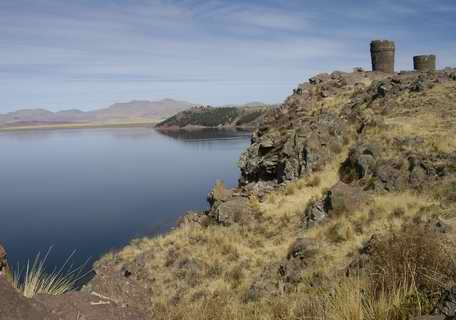 Time to move on
again, and time to descend somewhat from Titicaca's 3830m, which
eventually gave some relief to those in the group still suffering
headaches, and worse, from the altitude. But although Cuzco is only
3400m, we still had to go over a pass at 4300m. On the way we
visited the site of Sillustani, where the remains of stone
funerary towers (or Chullpas) erected by the Colla people stand out on
the volcanic crags above Lago Umaya. The highest tower illustrates that
the craft of intricate but massive stonework construction pre-dated the
Incas. It wasn't straightforward getting to the site though, as the
road was being 'resurfaced', the dirt topping being re-arranged. A line
of large stones, dusted white, blocked the road, and the 'diversion'
was a bumpy trail on the adjacent field. The coach driver didn't want
to take his coach over this, so he and the guide had long discussions
with the workmen, money changed hands, and we heaved the blocks aside
to let the coach pass. The same process was followed, with more
discussion, and less money, on the way back out!
Time to move on
again, and time to descend somewhat from Titicaca's 3830m, which
eventually gave some relief to those in the group still suffering
headaches, and worse, from the altitude. But although Cuzco is only
3400m, we still had to go over a pass at 4300m. On the way we
visited the site of Sillustani, where the remains of stone
funerary towers (or Chullpas) erected by the Colla people stand out on
the volcanic crags above Lago Umaya. The highest tower illustrates that
the craft of intricate but massive stonework construction pre-dated the
Incas. It wasn't straightforward getting to the site though, as the
road was being 'resurfaced', the dirt topping being re-arranged. A line
of large stones, dusted white, blocked the road, and the 'diversion'
was a bumpy trail on the adjacent field. The coach driver didn't want
to take his coach over this, so he and the guide had long discussions
with the workmen, money changed hands, and we heaved the blocks aside
to let the coach pass. The same process was followed, with more
discussion, and less money, on the way back out!
Sillustani Towers above Lago Umaya
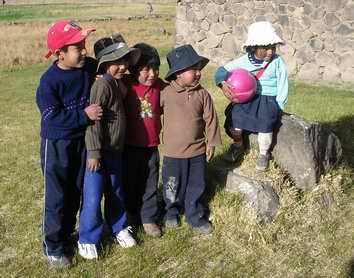
Nearby we briefly visited one of the altiplano farmsteads. Built
entirely of stone, and enclosed by stone walls, they house an extended
family living off rearing some livestock, growing potatoes and some
crafts - in the farm we visited they were weaving carpets. Corn and
other grains were still ground by hand using stones. The family were so
accommodating, showing us how they used their basic farming tools - I
couldn't imagine many English families being so friendly and willing to
be so scrutinised!
As it was 380km to Cuzco, it took a long time! Craft stalls at every
stop meant that it took even longer. Whilst visiting the strange Inca
town of Raqchi, with its huge stone & adobe walls of a temple, our
guide Eduardo - a former primary school teacher- showed off his child
control skills by getting the local kids, who were playing football
amongst the ruins, to march up and down, stand to attention and at
ease, as they have to each day in school...one of the reasons he left
teaching to become a guide!
Kids
at ease
This may sound odd, but arriving in Cuzco, just after dark, reminded me
of driving in the '80s into Sheffield from Barnsley on a winter
evening's rush hour! Cars were everywhere, lights dotted the hillsides
on either side of the valley, and semi-derelict (or half-built) small
factories or businesses lined the road. The illuminated main square
would soon dispel that image - but that didn't come until the next
night!
Sept 20

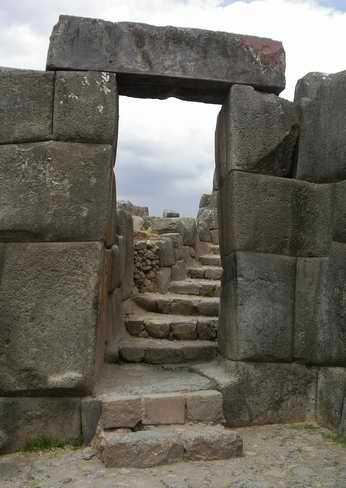 A day
of sightseeing in and around Cuzco with our guide, Ubaldo, began with a
coach ride up and out
to Pukapukara, a watchtower on a low hill surrounded by open country
and then a walk down to nearby Tambomachay, where the Incas channelled
water to trapezoidal openings in rocks and down through more channels
to other levels - something we were to see again on other sites. We
moved on to Q'enqo, where the Incas had carved steps and niches out of
the limestone rock, and also carved a kind of altar in a cave under the
middle of the site. Finally before lunch we walked down the hill to the
enormous site of Saqsaywaman, part religious part military, with large
natural amphitheatres and mounds that had been enhanced by terracing,
stone carving, and stone walls. Not only was it a fantastic display of
Inca building techniques - the large doorways still standing despite
earthquakes, the hand-holds still remaining carved on stones, the
zig-zag walls and long staircases - but it was still alive -
preparations were in hand for some student festival to be held on the
site the next day, for example, and locals still come up here on
certain days to pay respects to Pachamama, mother earth.
A day
of sightseeing in and around Cuzco with our guide, Ubaldo, began with a
coach ride up and out
to Pukapukara, a watchtower on a low hill surrounded by open country
and then a walk down to nearby Tambomachay, where the Incas channelled
water to trapezoidal openings in rocks and down through more channels
to other levels - something we were to see again on other sites. We
moved on to Q'enqo, where the Incas had carved steps and niches out of
the limestone rock, and also carved a kind of altar in a cave under the
middle of the site. Finally before lunch we walked down the hill to the
enormous site of Saqsaywaman, part religious part military, with large
natural amphitheatres and mounds that had been enhanced by terracing,
stone carving, and stone walls. Not only was it a fantastic display of
Inca building techniques - the large doorways still standing despite
earthquakes, the hand-holds still remaining carved on stones, the
zig-zag walls and long staircases - but it was still alive -
preparations were in hand for some student festival to be held on the
site the next day, for example, and locals still come up here on
certain days to pay respects to Pachamama, mother earth.
Carved altar at
Q'enqo
Doorway at
Saqsaywaman
Then for something completely different - after lunch it was into the
Cathedral - and what for many of the group was not an uplifting
spiritual experience but a disturbing display of misapplied riches - so
much gold and silver to symbolise religious power. Later we visited the
Iglesia de Santo Domingo, built on the site of the Inca temple of
Qorikancha. Some of the layout of the latter did not become evident
until the earthquakes of 1950 & 1986 destroyed the later parts
leaving the Inca walls intact.
Sept 21
We headed off by bus over the hills to the Sacred Valley, or
Urubamba valley, to visit two other Inca sites - Pisac and
Ollantaytambo. Both were located high on the north valley side, above
the valley bottom settlements with their Inca irrigation ditches still
being used. Pisac covered a huge area, four times as big as Machu
Picchu, with look-out areas and dwellings spread in places over the
steep terraced hillsides around and the main religious centre somewhat
lower down the hill. It was a slightly scary walk between the sites,
with narrow rough trails and steps, a tunnel and long drops. It was
also difficult to avoid the high-pitched whistling of the Peruvian
buskers stationed with their pipes on strategic points on the terraces,
or the Peruvian ladies hawking jewellery and knitwear. We walked down
hundreds of steps and terraces to reach the village of Pisac, where the
Sunday market was in full swing. 90% of the stalls were selling
touristy items, but 10% were selling fruit, veg, meat, fish, beans,
potatoes and spices for the locals. Many of us had freshly boiled corn
with cheese and a herby sauce as our lunch at only 3 sol.
It was a slightly scary walk between the sites,
with narrow rough trails and steps, a tunnel and long drops. It was
also difficult to avoid the high-pitched whistling of the Peruvian
buskers stationed with their pipes on strategic points on the terraces,
or the Peruvian ladies hawking jewellery and knitwear. We walked down
hundreds of steps and terraces to reach the village of Pisac, where the
Sunday market was in full swing. 90% of the stalls were selling
touristy items, but 10% were selling fruit, veg, meat, fish, beans,
potatoes and spices for the locals. Many of us had freshly boiled corn
with cheese and a herby sauce as our lunch at only 3 sol.
After a little difficulty in getting the group back to the bus - few of
us chose the right tree ( a beautiful mature tree with scarlet flowers
(a pisonay ? tree) - at which to turn right, so I had a little jog
round the market & adjacent streets for 15 minutes and eventually
found everyone.
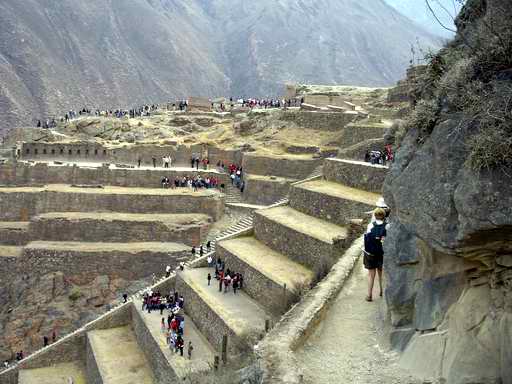 It is noticeable how our energy and interest declines
after lunch - so we were lulled into a semi-comatose state by the coach
ride down the valley to Ollantaytambo, and had difficulty waking up to
climb up the terraces (again) to visit the core of this site. The most
striking thing about this site for me was one main wall constructed
from huge blocks, with smaller tall blocks between them. These blocks
had, like most of the other stones on the main religious part of the
site, been quarried across the valley, and then brought across to the
valley and up a ramp to the site. To get the stone across the river the
Incas moved the rocks to the banks of the river, then diverted the
river to behind the rocks. Smart.
It is noticeable how our energy and interest declines
after lunch - so we were lulled into a semi-comatose state by the coach
ride down the valley to Ollantaytambo, and had difficulty waking up to
climb up the terraces (again) to visit the core of this site. The most
striking thing about this site for me was one main wall constructed
from huge blocks, with smaller tall blocks between them. These blocks
had, like most of the other stones on the main religious part of the
site, been quarried across the valley, and then brought across to the
valley and up a ramp to the site. To get the stone across the river the
Incas moved the rocks to the banks of the river, then diverted the
river to behind the rocks. Smart.
Ethnic and exotic forms of
backpack...
In the valley meadows
below the site there were some very elegantly
designed arrangements to channel water to the fields, through and under
the terraces, and in one case into narrow channels carved onto the top
of a large rock to give a couple of water spouts over a trough.
Ollantaytambo
.
Sept 22
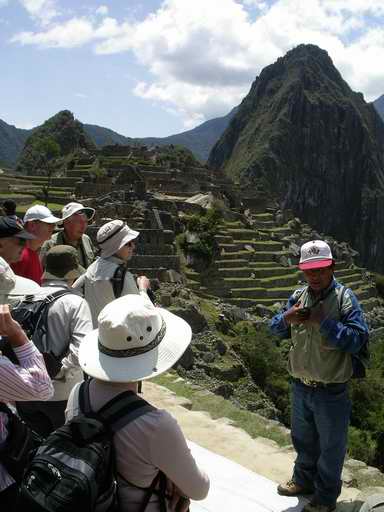 A horribly early
start - all in the good cause of seeing Machu Picchu - to get the
6.05 train to Aguas Calientes. It all started well, with our second
breakfast being served after we had trundled up the zig-zags out of
Cuzco, and had set off downhill towards the Urubamba valley. The
selling of CDs and Christmas decorations by the train staff had
finished when the train stopped - and didn't move again for another
hour and a half. There were two trains ahead of us, also stopped. The
problem? A fire in the forest on both sides of the track had led to a
rockfall onto the track. Eventually we rolled slowly on, and round the
smoke-filled bend in the valley we had an uncomfortably close view of
the fire, vertically above us. The delay meant that our guided visit of
Machu Picchu was rather rushed, from dashing through the market by the
station to get to the bus to dashing up and down steps and round stone
corridors in the site itself. However, nothing could detract from the
way the surrounding forest-covered mountains contrasted with the
ancient stonework of Machu Picchu; or the way the buildings seemed to
float vertically above the Urubamba river 400m below. Even the fact
that there were hundreds of other visitors hardly mattered - apart from
the queues to get round certain tight corners and dodging the cameras
and video recorders. We all felt moved as the guide, Ubaldo,
recounted various spiritual experiences he had had during 16 years
working at Machu Picchu, including spending the night on the site and,
less spiritual, running up and down Wayna Picchu in 29 minutes!
A horribly early
start - all in the good cause of seeing Machu Picchu - to get the
6.05 train to Aguas Calientes. It all started well, with our second
breakfast being served after we had trundled up the zig-zags out of
Cuzco, and had set off downhill towards the Urubamba valley. The
selling of CDs and Christmas decorations by the train staff had
finished when the train stopped - and didn't move again for another
hour and a half. There were two trains ahead of us, also stopped. The
problem? A fire in the forest on both sides of the track had led to a
rockfall onto the track. Eventually we rolled slowly on, and round the
smoke-filled bend in the valley we had an uncomfortably close view of
the fire, vertically above us. The delay meant that our guided visit of
Machu Picchu was rather rushed, from dashing through the market by the
station to get to the bus to dashing up and down steps and round stone
corridors in the site itself. However, nothing could detract from the
way the surrounding forest-covered mountains contrasted with the
ancient stonework of Machu Picchu; or the way the buildings seemed to
float vertically above the Urubamba river 400m below. Even the fact
that there were hundreds of other visitors hardly mattered - apart from
the queues to get round certain tight corners and dodging the cameras
and video recorders. We all felt moved as the guide, Ubaldo,
recounted various spiritual experiences he had had during 16 years
working at Machu Picchu, including spending the night on the site and,
less spiritual, running up and down Wayna Picchu in 29 minutes!
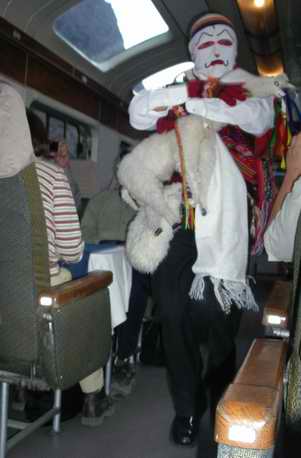
Ubaldo talks about his time at Machu Picchu
At that point where we wanted to relax and drink in the atmosphere we
were rushed back down the mountain to the train - the value of having a
guide to cut through the queues was evident. The train journey back was
slow (largely uphill) but steady. Again we were served food and drink,
but this time it was followed by a dancing 'clown' and a fashion show
of alpaca garments . The train staff must have a very odd job
description....
Clowning
on the Machu Picchu train
Back to Peru Trip Index
 Yavari Steamship
Yavari Steamship A day to play proper
tourists! Our guide, Eduardo, took us first to the Yavari, a former
steam ship constructed in England in 1862, then shipped (with its
sister ship) in 2766 parts to Peru, then brought over the Andes to Lake
Titicaca on mules and reconstructed in Puno - a 6 year process in all.
It was bought as a wreck
by an English woman in 1982 and has been restored. The current captain,
Carlos Saavedra, showed us around with a wealth of humorous
pearls of wisdom, and the odd fact. It took quite an effort to get him
to stop - but not until after we had seen the whole ship, including the
'new' diesel engine (1914), which removed the need to store tons of
llama dung for the steam engine...
A day to play proper
tourists! Our guide, Eduardo, took us first to the Yavari, a former
steam ship constructed in England in 1862, then shipped (with its
sister ship) in 2766 parts to Peru, then brought over the Andes to Lake
Titicaca on mules and reconstructed in Puno - a 6 year process in all.
It was bought as a wreck
by an English woman in 1982 and has been restored. The current captain,
Carlos Saavedra, showed us around with a wealth of humorous
pearls of wisdom, and the odd fact. It took quite an effort to get him
to stop - but not until after we had seen the whole ship, including the
'new' diesel engine (1914), which removed the need to store tons of
llama dung for the steam engine... Yavari Steamship
Yavari Steamship Time to move on
again, and time to descend somewhat from Titicaca's 3830m, which
eventually gave some relief to those in the group still suffering
headaches, and worse, from the altitude. But although Cuzco is only
3400m, we still had to go over a pass at 4300m. On the way we
visited the site of Sillustani, where the remains of stone
funerary towers (or Chullpas) erected by the Colla people stand out on
the volcanic crags above Lago Umaya. The highest tower illustrates that
the craft of intricate but massive stonework construction pre-dated the
Incas. It wasn't straightforward getting to the site though, as the
road was being 'resurfaced', the dirt topping being re-arranged. A line
of large stones, dusted white, blocked the road, and the 'diversion'
was a bumpy trail on the adjacent field. The coach driver didn't want
to take his coach over this, so he and the guide had long discussions
with the workmen, money changed hands, and we heaved the blocks aside
to let the coach pass. The same process was followed, with more
discussion, and less money, on the way back out!
Time to move on
again, and time to descend somewhat from Titicaca's 3830m, which
eventually gave some relief to those in the group still suffering
headaches, and worse, from the altitude. But although Cuzco is only
3400m, we still had to go over a pass at 4300m. On the way we
visited the site of Sillustani, where the remains of stone
funerary towers (or Chullpas) erected by the Colla people stand out on
the volcanic crags above Lago Umaya. The highest tower illustrates that
the craft of intricate but massive stonework construction pre-dated the
Incas. It wasn't straightforward getting to the site though, as the
road was being 'resurfaced', the dirt topping being re-arranged. A line
of large stones, dusted white, blocked the road, and the 'diversion'
was a bumpy trail on the adjacent field. The coach driver didn't want
to take his coach over this, so he and the guide had long discussions
with the workmen, money changed hands, and we heaved the blocks aside
to let the coach pass. The same process was followed, with more
discussion, and less money, on the way back out!

 A day
of sightseeing in and around Cuzco with our guide, Ubaldo, began with a
coach ride up and out
to Pukapukara, a watchtower on a low hill surrounded by open country
and then a walk down to nearby Tambomachay, where the Incas channelled
water to trapezoidal openings in rocks and down through more channels
to other levels - something we were to see again on other sites. We
moved on to Q'enqo, where the Incas had carved steps and niches out of
the limestone rock, and also carved a kind of altar in a cave under the
middle of the site. Finally before lunch we walked down the hill to the
enormous site of Saqsaywaman, part religious part military, with large
natural amphitheatres and mounds that had been enhanced by terracing,
stone carving, and stone walls. Not only was it a fantastic display of
Inca building techniques - the large doorways still standing despite
earthquakes, the hand-holds still remaining carved on stones, the
zig-zag walls and long staircases - but it was still alive -
preparations were in hand for some student festival to be held on the
site the next day, for example, and locals still come up here on
certain days to pay respects to Pachamama, mother earth.
A day
of sightseeing in and around Cuzco with our guide, Ubaldo, began with a
coach ride up and out
to Pukapukara, a watchtower on a low hill surrounded by open country
and then a walk down to nearby Tambomachay, where the Incas channelled
water to trapezoidal openings in rocks and down through more channels
to other levels - something we were to see again on other sites. We
moved on to Q'enqo, where the Incas had carved steps and niches out of
the limestone rock, and also carved a kind of altar in a cave under the
middle of the site. Finally before lunch we walked down the hill to the
enormous site of Saqsaywaman, part religious part military, with large
natural amphitheatres and mounds that had been enhanced by terracing,
stone carving, and stone walls. Not only was it a fantastic display of
Inca building techniques - the large doorways still standing despite
earthquakes, the hand-holds still remaining carved on stones, the
zig-zag walls and long staircases - but it was still alive -
preparations were in hand for some student festival to be held on the
site the next day, for example, and locals still come up here on
certain days to pay respects to Pachamama, mother earth. It was a slightly scary walk between the sites,
with narrow rough trails and steps, a tunnel and long drops. It was
also difficult to avoid the high-pitched whistling of the Peruvian
buskers stationed with their pipes on strategic points on the terraces,
or the Peruvian ladies hawking jewellery and knitwear. We walked down
hundreds of steps and terraces to reach the village of Pisac, where the
Sunday market was in full swing. 90% of the stalls were selling
touristy items, but 10% were selling fruit, veg, meat, fish, beans,
potatoes and spices for the locals. Many of us had freshly boiled corn
with cheese and a herby sauce as our lunch at only 3 sol.
It was a slightly scary walk between the sites,
with narrow rough trails and steps, a tunnel and long drops. It was
also difficult to avoid the high-pitched whistling of the Peruvian
buskers stationed with their pipes on strategic points on the terraces,
or the Peruvian ladies hawking jewellery and knitwear. We walked down
hundreds of steps and terraces to reach the village of Pisac, where the
Sunday market was in full swing. 90% of the stalls were selling
touristy items, but 10% were selling fruit, veg, meat, fish, beans,
potatoes and spices for the locals. Many of us had freshly boiled corn
with cheese and a herby sauce as our lunch at only 3 sol.  It is noticeable how our energy and interest declines
after lunch - so we were lulled into a semi-comatose state by the coach
ride down the valley to Ollantaytambo, and had difficulty waking up to
climb up the terraces (again) to visit the core of this site. The most
striking thing about this site for me was one main wall constructed
from huge blocks, with smaller tall blocks between them. These blocks
had, like most of the other stones on the main religious part of the
site, been quarried across the valley, and then brought across to the
valley and up a ramp to the site. To get the stone across the river the
Incas moved the rocks to the banks of the river, then diverted the
river to behind the rocks. Smart.
It is noticeable how our energy and interest declines
after lunch - so we were lulled into a semi-comatose state by the coach
ride down the valley to Ollantaytambo, and had difficulty waking up to
climb up the terraces (again) to visit the core of this site. The most
striking thing about this site for me was one main wall constructed
from huge blocks, with smaller tall blocks between them. These blocks
had, like most of the other stones on the main religious part of the
site, been quarried across the valley, and then brought across to the
valley and up a ramp to the site. To get the stone across the river the
Incas moved the rocks to the banks of the river, then diverted the
river to behind the rocks. Smart.  A horribly early
start - all in the good cause of seeing Machu Picchu - to get the
6.05 train to Aguas Calientes. It all started well, with our second
breakfast being served after we had trundled up the zig-zags out of
Cuzco, and had set off downhill towards the Urubamba valley. The
selling of CDs and Christmas decorations by the train staff had
finished when the train stopped - and didn't move again for another
hour and a half. There were two trains ahead of us, also stopped. The
problem? A fire in the forest on both sides of the track had led to a
rockfall onto the track. Eventually we rolled slowly on, and round the
smoke-filled bend in the valley we had an uncomfortably close view of
the fire, vertically above us. The delay meant that our guided visit of
Machu Picchu was rather rushed, from dashing through the market by the
station to get to the bus to dashing up and down steps and round stone
corridors in the site itself. However, nothing could detract from the
way the surrounding forest-covered mountains contrasted with the
ancient stonework of Machu Picchu; or the way the buildings seemed to
float vertically above the Urubamba river 400m below. Even the fact
that there were hundreds of other visitors hardly mattered - apart from
the queues to get round certain tight corners and dodging the cameras
and video recorders. We all felt moved as the guide, Ubaldo,
recounted various spiritual experiences he had had during 16 years
working at Machu Picchu, including spending the night on the site and,
less spiritual, running up and down Wayna Picchu in 29 minutes!
A horribly early
start - all in the good cause of seeing Machu Picchu - to get the
6.05 train to Aguas Calientes. It all started well, with our second
breakfast being served after we had trundled up the zig-zags out of
Cuzco, and had set off downhill towards the Urubamba valley. The
selling of CDs and Christmas decorations by the train staff had
finished when the train stopped - and didn't move again for another
hour and a half. There were two trains ahead of us, also stopped. The
problem? A fire in the forest on both sides of the track had led to a
rockfall onto the track. Eventually we rolled slowly on, and round the
smoke-filled bend in the valley we had an uncomfortably close view of
the fire, vertically above us. The delay meant that our guided visit of
Machu Picchu was rather rushed, from dashing through the market by the
station to get to the bus to dashing up and down steps and round stone
corridors in the site itself. However, nothing could detract from the
way the surrounding forest-covered mountains contrasted with the
ancient stonework of Machu Picchu; or the way the buildings seemed to
float vertically above the Urubamba river 400m below. Even the fact
that there were hundreds of other visitors hardly mattered - apart from
the queues to get round certain tight corners and dodging the cameras
and video recorders. We all felt moved as the guide, Ubaldo,
recounted various spiritual experiences he had had during 16 years
working at Machu Picchu, including spending the night on the site and,
less spiritual, running up and down Wayna Picchu in 29 minutes!